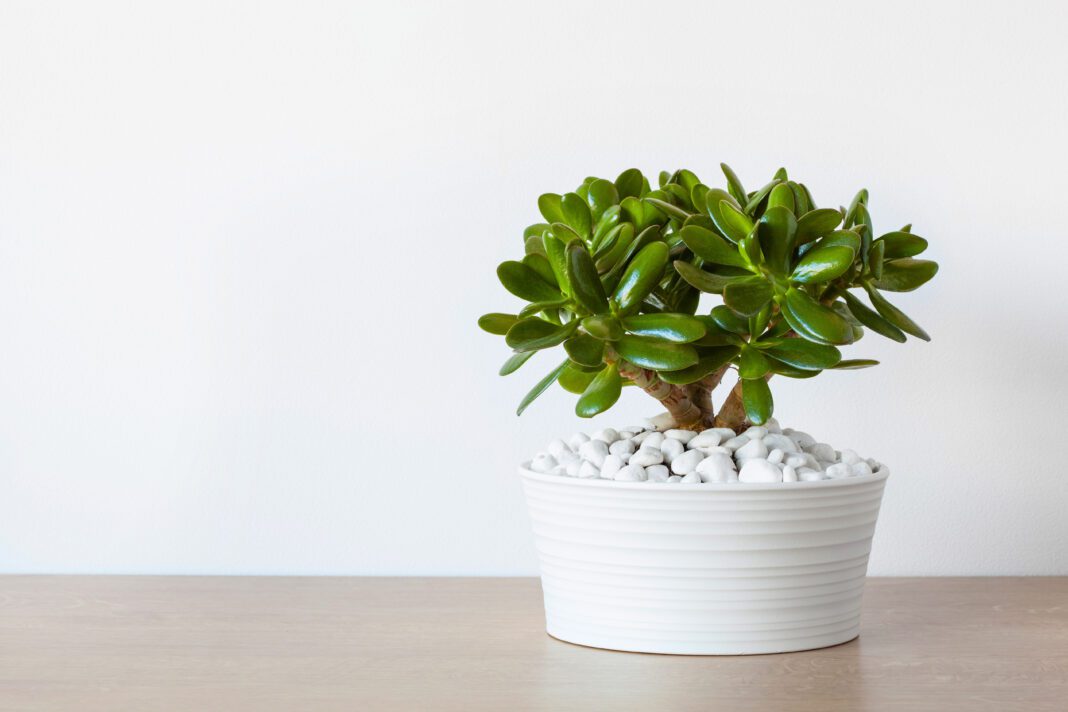Jade plant benefits: Quick look
|
The Jade plant (Crassula ovata) is a very popular, auspicious plant that grows indoors and outdoors. It is an ideal housewarming gift and wedding gift bonsai plant with thick, woody stems and branches. This plant acts as a succulent that will retain water well within the leaves stems and swollen roots. Jade plant benefits are very easy to maintain, purify the air, can last for years, and many more. Jade plant benefits are purifying the air and increasing indoor humidity.

Botanical description
- It has thick, shiny, smooth, egg-shaped leaves that grow in opposing pairs along the branches.
- The leaf is vibrant green to yellow-green and highlighted red if the plant is cultivated in direct sun.
- This plant produces small white or pink star-like blossoms with a faint sweet scent displayed in early spring.
- The flowers develop into small capsules, each holding many tiny seeds.
Geographical distribution
This plant is native to South Africa and Mozambique as well as grown in Europe and America for over 100 years.
Common Names
Crassula Ovata, C. portulacea, C. argentea (botanical/scientific name), Friendship plant, Lucky Plant, Money plant, Penny Plant, Dollar Plant, Tree of Happiness, Money Vine, Fortunate Plant, Baby Jade, Dwarf rubber plant, Chinese rubber plant, Japanese rubber plant, and Cauliflower Ears,
How to take care of Jade plant
For a healthy jade plant, proper conditions like water, light, temperature, and fertilizer are required. Let’s take a close look at some of these guidelines.
1. Soil
Well-drained humus-rich soil is best, to avoid root rot of these plants.
2. Water
This plant requires watering only when the top of the soil is dry in the summer and spring season.
Also, remove excess water because it may cause rotting of roots and stems. Overwatering may cause yellow-brown spots and loss of the leaves. Suspend watering during the dormant winter period.
3. Light
Sunlight is one of the most important things in the care and maintenance of jade plants. They need full sun bright light to grow properly and produce flowers.
If they do not have full sun, they may become stunted, resulting in narrow leaves, leggy and grayish shed. They are best indoors with a sunny window or south-facing windows. But make sure to keep outside at least once in a week in full sun for better growth.
4. Temperature
Jade plant prefers daytime temperatures of 65-70 Fahrenheit during the day and 50-55 Fahrenheit at night.
5. Fertilizer
Feeding the plant with a low-nitrogen fertilizer solution at the beginning of the growing season is ideal for the best growth. Suspend fertilizing during the dormant winter period.
6. Repotting
This plant does not require to be repotted often but the soil needs renewing every 3 years. Repot as needed, preferably after the flowers have bloomed or during the warm season.
Prune the roots when repotting into the same size pot. Cut the stems to maintain the shape and encourage the development of a thick main trunk. Water carefully until established in the new container.
7. Jade Plant Propagation
Jade plants can be easily propagated using stem cuttings or a single leaf. Both of these types of cuttings require high humidity. These have to dry for a few days until the wound has closed. After some days place it on soil mix or in water and wait for roots to develop.
Jade plant benefits as an indoor plant
Jade plant has various benefits let look at some of these as follows
1. Purifies air
Indoor air pollution is one of the major concerns that may cause asthma, dizziness, fatigue, nausea, and loss of focus. However, jade plants not only add beauty to the indoor environment but also like other indoor air-purifying plants, purify certain harmful gases.
2. Absorbs carbon dioxide at Night
The jade plant can absorb the carbon dioxide it needs for growth during the dark hours. Thus this plant releases oxygen in the air and improves indoor air quality in the nighttime.
3. Brings good fortune for home
Jade is an evergreen herb that is considered a good luck symbol in Feng shui. Moreover, this plant increases and stimulates “chi” inspirational and positive energy for fixing any Vastu or Feng Shui defects.
Thus this plant is useful as a housewarming gift, as well as for weddings, anniversaries, birthdays, and other occasions.
4. Easy to Maintain
The Jade plant is the easiest houseplant to grow because it is slow-growing, and doesn’t need regular watering, repotting as well or fertilization.
These plants will get thick tree-like branches and can last for years and years.
5. Increase humidity
Low indoor humidity may cause various health problems such as dry and irritated eyes, and flaky, and itchy skin.
Moreover, it also increases the risk of cold, flu, and other infections. However, jade plants act as a humidifier that helps to increase the humidity of an interior (1).
Jade plants benefits as a medicinal plant
1. May treat warts
Leaf of the jade plant was used to treat warts which are small circumscribed tumors of the outer layer of the skin. They are caused by forms of the infectious human papillomavirus (HPV).
However, leaves were sliced in half and attached the moist inside to the wart for a few hours, or overnight. It was suggested that after 3 applications, it can reduce the growth of the infection.
2. Potential antidiabetic and antioxidant properties
Jade plant leaves contain phytochemicals such as saponin, phenol, phytosterol, steroids, terpenoids, flavonoids, carbohydrates, and proteins. These compounds may help to inhibit alpha-amylase activity that decreases the absorption of glucose and consequently reduce blood glucose level.
Jade plant tea and juice are beneficial to treat symptoms of diabetes. Also, scavenges harmful radicals from the body and protects from various diseases (2).
3. May treat high blood pressure
The gallic acid found in jade plant leaves possibly helps in reducing the tension of the blood vessel walls. Thus this plant shows a wonderful effect on the widening of blood vessels, which in turn increases blood flow and lowers blood pressure (3).
4. Antimicrobial properties
Jade plant leaves are rich in alkaloids like Berberine Sanguinarine, and saponins. These bioactive compounds may fight against various bacteria such as Escherichia coli, Pseudomonas, and Klebsilla sp. thus protecting from various infections (2), (4).
Other medicinal benefits of the Jade plant
- In folk medicine, jade leaves are used to treat high blood pressure and can alleviate headaches, dizziness, stomachache, and liver injury.
- In certain areas, this plant is often used as a treatment for nausea.
- Jade leaves are used to treat diarrhea, epilepsy, and corns, and as a purgative in Africa.
- The Kamba community used its juice to heal a burn, and wounds on the skin.
- Other communities like the Maasai use it as a relief for stomach upsets
Toxicity of Jade plant
Toxic to human
This plant does not cause any toxicity to humans however exposure to plant and leaf sap may cause contact dermatitis (5). Whereas other research reported that, the jade plant may cause human-plant poisoning following the ingestion of leaves, particularly by children (6).
Toxic to pets
The toxins in the jade plant that are poisonous are still unknown however these plant leaves are toxic to cats if left untreated. When ingested, this plant may cause vomiting, depression, a slowed heart rate, and a loss of coordination. It also causes abdominal pain, lethargy, weakness, aggression, hiding, impaired muscle movement (rare), and convulsions (rare) (7).
Q&A
Is jade plant poisonous?
Ingestion of excessive amounts of the jade plant is poisonous to pets whereas it is mildly toxic to humans when in contact with the skin.
Where to place a Jade Plant?
It is best to keep the jade plant in front of the office or close to your main entrance. Another good place is in the southeast, west, or northwest corner of your home. Do not place it in the bedroom or bathroom.
How much water do jade plants need?
Jade plants act like cactus plant that stores the water in their leaves so this plant only needs water at a moderate level. Keep watering only when the top of the soil is dry. Never sit your plant in water or remove excess water because it may cause rotting of roots and stems.
Is jade an indoor plant?
Jade is an evergreen plant that can be grown outdoors as well as indoor.
